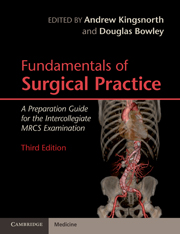Book contents
- Frontmatter
- Contents
- List of contributors
- Preface
- Section 1 Basic Sciences Relevant to Surgical Practice
- Section 2 Basic Surgical Skills
- Section 3 The Assessment and Management of the Surgical Patient
- Section 4 Perioperative Care of the Surgical Patient
- Section 5 Common Surgical Conditions
- 16 Assessment and early treatment of patients with trauma
- 17 Fundamentals of the central nervous system
- 18 Fundamentals of head and neck surgery
- 19 Fundamentals of thoracic surgery
- 20 Oesophago-gastric surgery
- 21 Fundamentals of hepatobiliary and pancreatic surgery
- 22 Fundamentals of endocrine surgery
- 23 Fundamentals of the breast
- 24 Lower gastrointestinal surgery
- 25 Fundamentals of the genitourinary system
- 26 Hernias
- 27 Fundamentals of vascular surgery
- 28 Fundamentals of orthopaedics
- 29 Fundamentals of plastic surgery
- 30 Surgical care of the paediatric patient
- 31 Fundamentals of organ transplantation
- Index
- References
19 - Fundamentals of thoracic surgery
Published online by Cambridge University Press: 03 May 2011
- Frontmatter
- Contents
- List of contributors
- Preface
- Section 1 Basic Sciences Relevant to Surgical Practice
- Section 2 Basic Surgical Skills
- Section 3 The Assessment and Management of the Surgical Patient
- Section 4 Perioperative Care of the Surgical Patient
- Section 5 Common Surgical Conditions
- 16 Assessment and early treatment of patients with trauma
- 17 Fundamentals of the central nervous system
- 18 Fundamentals of head and neck surgery
- 19 Fundamentals of thoracic surgery
- 20 Oesophago-gastric surgery
- 21 Fundamentals of hepatobiliary and pancreatic surgery
- 22 Fundamentals of endocrine surgery
- 23 Fundamentals of the breast
- 24 Lower gastrointestinal surgery
- 25 Fundamentals of the genitourinary system
- 26 Hernias
- 27 Fundamentals of vascular surgery
- 28 Fundamentals of orthopaedics
- 29 Fundamentals of plastic surgery
- 30 Surgical care of the paediatric patient
- 31 Fundamentals of organ transplantation
- Index
- References
Summary
Surgical anatomy
Tracheobronchial tree
The bony skeleton of the larynx consists of the hyoid bone superiorly, and the thyroid and cricoid cartilages, from which the trachea is suspended. The thickened edge of the cricovocal membrane forms the cricovocal ligament, which is covered with mucous membrane and thus forms the vocal fold (cord). The vocal cord is responsible not only for phonation, but also for protection of the tracheobronchial tree from food and fluids during deglutition. The nerve supply of the vocal cords is largely by the recurrent laryngeal nerves, which originate from the vagus nerve within the thorax. On the right side the recurrent laryngeal nerve originates in the root of the neck, hooks around the right subclavian artery and ascends to the larynx between the trachea and oesophagus. On the left it originates at the level of the aortic arch in the thorax, hooks around the ligamentum arteriosum, and ascends to the right of the aortic arch, again between the trachea and oesophagus. Thus the left recurrent laryngeal nerve in particular is susceptible to involvement by mediastinal pathology.
The laryngeal prominence (Adam's apple) is formed by the junction of the two laminae of the thyroid cartilage. Below this is the cricoid cartilage, and between the two is the cricothyroid membrane which is the landmark used for emergency cricothyroidotomy or more commonly, the insertion of a minitracheostomy (Figure 19.1).
- Type
- Chapter
- Information
- Fundamentals of Surgical PracticeA Preparation Guide for the Intercollegiate MRCS Examination, pp. 330 - 342Publisher: Cambridge University PressPrint publication year: 2011

